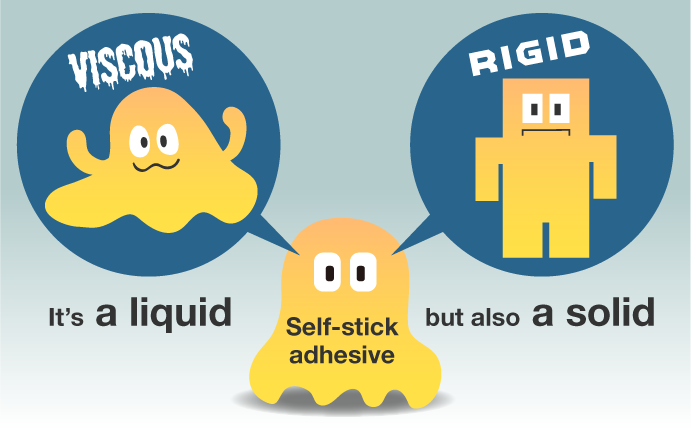What is the basic sticking mechanism of a sticker?
When sticking, self-stick adhesive “penetrates” the unevenness on the surface by applying “pressure”!
The surface to which the sticker sticks has pits and projections.
Although paper and other solids seem to have smooth surfaces, their surfaces are actually uneven. The self-stick adhesive of stickers penetrates into this unevenness, allowing the sticker to stick on a solid object.
What kind of structure does a sticker actually have?
It is difficult to understand at a glance, but stickers have a multi-layer structure as shown below.

- Surface layer: The front face of a sticker.
- Substrate layer: A supporting layer to retain the shape of the sticking component. Paper or plastic films are used.
- Self-stick adhesive: A layer of sticking component.
- Bottom paper: The paper for putting the sticker on top. Paper and plastic films are used.
What are the prerequisites for objects to stick?
"Objects need to get close to one another at a molecular level.
That is, the self-stick adhesive should securely penetrate into pits and projections of the surface to stick to. There are various other reasons such as sufficient wettability, static electricity, and anchor effect of the surface. If you are interested, please check the links at the bottom of this page."
The key is to secure penetration into pits and projections
You may have been surprised to know that there are pits and projections on the surface, as we told you in the beginning. Things that seem to have smooth surfaces at a glance in fact have pits and projections on the surface. Stickers stick because the self-stick adhesive of the stickers penetrate into these pits and projections. In other words, when sticking a sticker, applying pressure thoroughly will cause the adhesive component to penetrate adequately into the pits and on the projections and secure a firm adhesion. At this time, if the adhesive does not penetrate adequately into the pits and is applied only on the projections, the contact area is small, resulting in reduced adhesive power to be exerted. Conversely, there are also easily removed stickers with reduced adhesive power, which is achieved by suppressing penetration of the self-stick adhesive. However, not all such stickers use this method. There are various other methods, such as changing the type of self-stick adhesive.


This type of self-stick adhesive that sticks by applying pressure is also called “pressure-sensitive adhesive.”
How does the rigid looking self-stick adhesive penetrate into unevenness?
This is related to the properties of self-stick adhesive. Self-stick adhesive actually has two properties of liquid and solid. The liquid property allows the self-stick adhesive to flow when pressure is applied, enabling it to penetrate securely into pits and projections.

The stickers pasted using the above property require some effort to remove. Next time, we’ll look at tips for removing stickers and the mechanism by which they can be removed!
